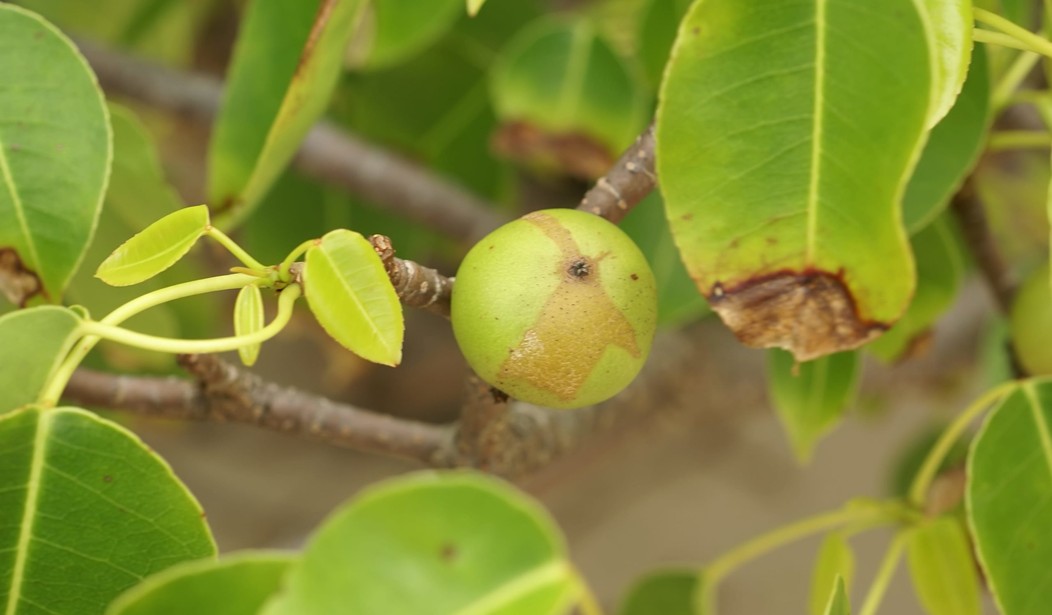If I asked the average person what the worst plants on the planet were, they might suggest poison oak, a particularly nasty-tasting vegetable, or whatever weed produces those obnoxious seeds that stick to your socks when you mow the lawn. But you may be surprised to learn about some of nature’s most horrifying plant life…
1. Manchineel Tree
https://twitter.com/ThomHaye/status/872059428715057152
The manchineel tree tops my list as the all-time scariest tree on the face of the Earth, and if you plan on vacationing in the Florida Everglades, the Caribbean, or Central America, it’s well worth understanding why this plant is a living nightmare. First off, if a careless tourist decided to try one of those tasty-looking “beach apples” from one of the trees growing along the sandy shores, they will quickly suffer with a swollen mouth and tongue from attempting to ingest the highly toxic fruit, followed by nausea, vomiting, diarrhea, seizures, and likely death. Locals have a cute nickname for the fruit of the manchineel tree: “little apples of death.”
Even if you’re smart enough to keep yourself from eating every unidentified fruit you come across like a starved monkey, the horrifically toxic manchineel tree does everything within its power to keep everyone and everything away from it. Its branches and twigs are filled with a milky white sap that will cause your skin to blister, grow boils, and burn on contact. Merely standing under the tree during a storm is a terrible idea, as the rain will wash the skin-burning sap down onto anything underneath its branches, and you can’t even park your car under a manchineel, as its corrosive sap will eat through the paint!
Ok, I know what you’re thinking: “Why hasn’t mankind destroyed all of these terror trees yet?!” There are a few good reasons: It’s technically listed as an endangered species by the state of Florida, but more importantly, burning the wood of the manchineel tree releases a nasty smoke that can cause blindness if it gets in your eyes.
Even the legendary Juan Ponce de León met his end when his leg was struck by an arrow coated with manchineel tree poison during a battle with Florida natives and suffered a slow, painful death. The good news is that local governments are very careful to set up clear signage about what these pretty 50-foot tall trees are, and why everyone should steer clear them.
2. Castor Oil Plants
#onthisday in 1929 Kew sent 'castor oil seeds' (Ricinus communis) to a local polytechnic for study–the patterned seeds both kill and cure! pic.twitter.com/kY0yhob9Rt
— Kew Mobile Museum (@KewMobileMuseum) May 10, 2017
Castor oil plants have extremely poisonous seeds that might already be in your garden; the Guinness Book of World Records has awarded it the title of the world’s most dangerous plant. Its seeds contain ricin, a chemical compound that is easily more toxic than cyanide or the nastiest of snake venoms, and consuming four to eight of these brown speckled seeds will easily kill an adult. Symptoms that come with eating castor oil beans include nausea, diarrhea, rapid heartbeat, hypotension, dehydration, and seizures, but as incredibly poisonous as their seeds are, castor oil plants are cultivated for castor oil, which sports antifungal and antibacterial properties that may aid in treating skin conditions, promote a healthy immune system, and pain relief.
3. Gympie-Gympie, i.e. “Stinging Tree”
https://twitter.com/hoangvananh2911/status/888766925966254080
Australia already has a reputation for animals that will ruin your day, and not to be outdone by the New World’s manchineel tree, the Gympie-Gympie, i.e. “stinging tree” or “suicide plant,” will ruin the next six months of your life if you brush up against it. This tree has large green heart-shaped leaves that are covered in tiny hair-like needles that easily embed themselves into the flesh of any human unlucky enough to walk into it. The agony begins instantly, as victims have described the leaf’s sting like being burned with hot acid and electrocuted at the same time. And it gets worse. The needles are so fine that it is extremely difficult to remove them from your skin, and while they will fall out naturally over half a year or so, the area will continue to experience long-term temperature sensitivity and pain.
The syringe-like hairs remain active even on long-dead brown leaves, and people who work in the forests where Gympie-Gympie trees are known to thrive wear thick gloves and respirators to keep from getting stung. There have been tales of painful encounters with Australia’s stinging tree, including a horse that died from shock two hours after being stung. And during World War II, an officer shot himself after using a leaf as “toilet paper.” (Ow.)
Les Moore, who works with the CSIRO Division of Wildlife and Ecology in Queensland, was struck in the face by a stinging tree while studying cassowaries in the wild, and he recalled his own horror story:
I think I went into anaphylactic shock and it took days for my sight to recover. Within minutes the initial stinging and burning intensified and the pain in my eyes was like someone had poured acid on them. My mouth and tongue swelled up so much that I had trouble breathing. It was debilitating and I had to blunder my way out of the bush.
The legendary pain associated with this tree caught the attention of the British Army, which collected samples and attempted to turn it into some kind of chemical weapon in 1968. Luckily enough for the enemies of the UK, there are no known weapons that utilize this fearsome stinging plant. Next time you prick a finger on a thorny vine or whine about collecting pine cones off the lawn, just be thankful that you don’t have any suicide plants in your backyard.









Join the conversation as a VIP Member